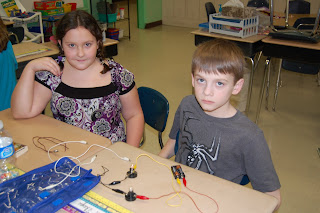Students from Mrs. Christy Perez's class experimenting on how to make a light bulb work.
Sunday, January 31, 2010
Laurel Shastri
Laurel Shastri is the co-artistic director of Ballet Tennessee. Ms. Shastri has worked as a teaching artist in residence in the Hamilton County Public School System, Lights On, and Dance Alive programs since 1996. IN her work, she incorporates techniques from the National Dance Institute, Southeast Center for Dance Education, and Brain Dance developed by Anne Green-Gilbert.
This hands-on lesson plan demonstration highlights the relationships between potential and kinetic energy and dance. Participants explore through movement, the similarities and differences between the dance concept of energy and the scientific definition. Participants will be able to demonstrate potential energy and kinetic energy as well as other related science concepts through dance. They will also gain knowledge of shape, level, time, locomotor, and nonlocomotor movements, and other dance concepts. Incorporated within the lesson are: introduction or review of dance concepts, exploration of dance concepts using scientific vocabulary, teamwork, creative problem solving, assessment of participant's knowledge of vocabulary, and artistic assessment.
This came from the lesson plans she sent for the 4th/5th grade residency.
How are dance and science alike?
How can we use dance to learn about science? How can we use science to learn about dance?
What are some of the similarities and differences between scientists and dancers?
Brief discussion: Space, how dancers use space and how stage directions are analogous to a coordinate system of graphing.
What is the difference between speed and velocity?
In dance terminology, velocity would give you information about direction (space) as well as how fast or slow (time) whereas speed would give information about how fast or slow only.
What is force? What forces act upon a dancer’s body? How do dancers use these forces in order to create a dance?
● Balanced forces
● Gravity
● Friction
● Pushing
● Pulling
● Stillness
What is dance? Is it possible to use dance to learn about science? Why or why not? What is potential energy? What is kinetic energy?
This hands-on lesson plan demonstration highlights the relationships between potential and kinetic energy and dance. Participants explore through movement, the similarities and differences between the dance concept of energy and the scientific definition. Participants will be able to demonstrate potential energy and kinetic energy as well as other related science concepts through dance. They will also gain knowledge of shape, level, time, locomotor, and nonlocomotor movements, and other dance concepts. Incorporated within the lesson are: introduction or review of dance concepts, exploration of dance concepts using scientific vocabulary, teamwork, creative problem solving, assessment of participant's knowledge of vocabulary, and artistic assessment.
This came from the lesson plans she sent for the 4th/5th grade residency.
How are dance and science alike?
How can we use dance to learn about science? How can we use science to learn about dance?
What are some of the similarities and differences between scientists and dancers?
Brief discussion: Space, how dancers use space and how stage directions are analogous to a coordinate system of graphing.
What is the difference between speed and velocity?
In dance terminology, velocity would give you information about direction (space) as well as how fast or slow (time) whereas speed would give information about how fast or slow only.
What is force? What forces act upon a dancer’s body? How do dancers use these forces in order to create a dance?
● Balanced forces
● Gravity
● Friction
● Pushing
● Pulling
● Stillness
What is dance? Is it possible to use dance to learn about science? Why or why not? What is potential energy? What is kinetic energy?
Subscribe to:
Comments (Atom)


























































